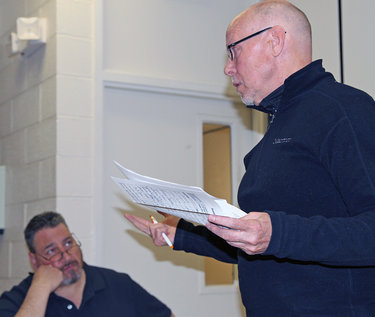Pyramid, with struggles in Syracuse, aims to build 222-unit complex in Guilderland
GUILDERLAND — Seeking to diversify from just retail, Pyramid hopes to build an apartment complex in Guilderland as its large mall in Syracuse is facing financial difficulties.
Meanwhile, Pyramid is facing concerns raised by local neighborhoods as it plans to build a complex of 222 apartments and townhouses on Rapp Road near its Crossgates Mall. Residents of Westmere Terrace want no through traffic to the complex (see related story).
To keep from increasing traffic through the African-American settlement known as the Rapp Road Historic District, which is on the national and state registers of historic places, Pyramid proposed to the Albany County Planning Board on April 18 that Rapp Road could be closed to through traffic from the proposed complex, the ring road, and Western Avenue.
Finances: The big picture
Michael Shanley of Pyramid told The Enterprise in November, when the company first proposed the residential complex, that Pyramid viewed the apartment project as an effort to “maintain Crossgates as an asset for our families and also for the town of Guilderland.” He said that Crossgates had, for many years, been focused solely on retail, but that that market is changing and the company is looking for other alternatives.
Pyramid’s mortgages on its Destiny USA in Syracuse, one of the largest malls in the country, was recently moved to a special servicer that deals with defaults or negotiations of loan terms; the servicer said it expects the mall owner, Pyramid Management Group, to default when the mortgage is due in June, according to the Wall Street Journal, which reports that Pyramid said it is now in discussions for an extension on its mortgage.
Kroll Bond Rating Agency downgraded the Class D and Class E certificate in a $430 million large loan transaction held by Pyramid and collateralized by two mortgage loans. The downgrades were driven by the transaction’s decline in operating performance, higher deal level loan-to-value ratio reflecting lower net cash flow and capitalization rate increases, and concerns about the loan’s refinancing at final maturity in a potentially less favorable financing environment for malls.
The mall has two mortgage loans, according to Kroll. The first has a balance of $300 million, secured by a mortgage of abourt 1.2 million square feet — the first phase of the mall, which had been called Carousel Center. It has three traditional anchor stores: Macy’s, JCPenney, and Lord & Taylor. While JCPenney is part of the loan collateral, the other two anchors own their own stores.
The second mortgage loan has a balance of $130 million and is secured by a mortgage on an 874,200-square-foot expansion parcel, a Phase 2 of the mall project. It is “primarily comprised of outlet retailers, restaurants and entertainment venues,” Kroll says.
Similarly, Crossgates Mall has, in recent years, moved to restaurant and entertainment venues. Crossgates Mall’s general manager, Michael Gately, told The Enterprise two years ago that up to 20 percent of Crossgates’ space is now dedicated to enterprises other than retail sales.
The credit performance of each loan is predicated on the overall performance of the mall, according to Kroll Bond Rating Agency.
According to Kroll, the loan-to-value ratio has risen to 94.6 percent, up from 88.2 percent at last review, and 82.7 percent at securitization.
David Aitken, Pyramid’s director of government affairs, declined to comment, and Pyramid executives Michael Shanley and James Soos did not return calls asking for comment.
Pyramid is seeking $1.5 million in tax credits from the Guilderland Industrial Development Agency, on the apartment-and-townhouse project.

Nearly everyone in the large crowd at the Albany County Planning Board’s April 18 meeting was there for the discussion of the proposed Rapp Road apartment-and-townhouse complex.
Pyramid’s traffic plan
If Pyramid closes Rapp Road to through traffic from the proposed complex, the ring road, and Western Avenue, traffic would still be able to go from Western Avenue to Gipp Road and then to Rapp Road and out to Washington Avenue Extension, and the reverse, the board heard.
Pyramid’s traffic consultant, John Collins of Maser Consulting, told the board, “The intent here was to lower the volume of traffic using Rapp Road between Gipp and Washington Avenue Extension.”
Closing Rapp Road at that spot would reduce by 135 the vehicles traveling that portion of Rapp Road during the morning peak hour, Collins said, and by over 200 in the evening peak hour. A traffic study by Maser Consulting had earlier estimated that 60 percent of the trips generated by the project would enter or exit via the ring road system and that the remaining 40 percent would use Rapp Road.
A member of the board asked how the closure would affect other intersections and was told that, because there are a variety of other routes that vehicles can take, the volume of traffic rerouted to any particular location wouldn’t be heavy.
Neil Gifford, the Pine Bush Commission’s conservation director, said that there is an ecological benefit in reducing through traffic. He said the closure would benefit not only the endangered Karner blue butterfly indigenous to this area but also some reptiles and amphibians that cross the road there.
The closure proposal was made in response to complaints from the Rapp Road Historical Neighborhood at last month’s Albany County Planning Board meeting. At that meeting, several neighborhood representatives expressed concern about the effect that the apartment project would have on traffic along already-congested Rapp Road.
The neighborhood has houses built in the 1930s through the 1960s by African-American families from Shubuta, Mississippi fleeing the Jim Crow South, many of which are still inhabited by descendants of the original settlers.
Last month, Juanita Nabors, who lives in the historic neighborhood, told the board that Rapp Road is already very congested. She asked the board, “How many of you at the end of your driveway when backing out wait for 10 or 15 cars to go by bumper-to-bumper, to get out?”
This month, Nabors told the board, “I’m going to be inconvenienced to get to Price Chopper, but I’m willing for the inconvenience. I’m willing to do that to eliminate the traffic that now comes over Rapp Road. We’ve got to start somewhere, and I think the proposal that you have come up with is worth considering.”
Going from the corner of Rapp and Gipp roads to Price Chopper via Gipp Road adds a mile to the trip. Going to Price Chopper directly from Rapp and Gipp is a trip of six-tenths of a mile, while going via the length of Gipp Road and then down Western is a total of 1.6 miles.
Beverly Bardequez, the head of the neighborhood association, told the board, “I have been waiting to hear from someone at Pyramid, and I’m still waiting. We’re neighbors, and we need to have dialogue.” She mentioned that she had had a good talk with Pyramid executive James Soos early on.
Other neighbors gave Pyramid a hint of opposition to come.
Margaret Callahan, who told the board she lives one block from the corner of Rapp and Gipp roads, said she was disappointed that the city of Albany hasn’t done anything in “all these years” about traffic in the area. She also said, “Anyone who lives within that small area now is going to be forced to drive up Gipp to Western and over to Price Chopper,” which she called “very inconvenient.”
Tom Hart, who lives on Westmere Terrace, asked whether Pyramid officials had spoken to residents of Gipp Road and the surrounding area about the greater inconvenience they would face in getting to Western Avenue. A representative of Chazen Companies, the engineering firm on the project, said that they had not, but that they would.
One of the documents Pyramid submitted was a traffic study, conducted in 2016 by Creighton Manning. The study noted that, as part of the Capital District Transportation Authority’s Transit Center proposal, a transit center would be built on the southern side of the existing mall that would provide direct access from the transit center into the food court on the Crossgates Mall’s second level.
Two roundabouts would be built, one where the main entrance to the mall meets the ring road, and the other at the Northway ramps. The “English couplet” main entrance to the mall would also be replaced with a standard “T” intersection. A portion of the ring road would be realigned.
A letter from Creighton Manning project traffic managers to the New York State Department of Transportation and a memorandum from Creighton Manning to the CDTA included with the traffic study both say that the improvements will allow the ring road to function more efficiently, divert traffic from Western Avenue, and minimize impacts at the mall’s main entrance intersection during peak periods. The improvements will also, the documents say, reduce queuing approaching the ring road from the Northway.
“Queuing on this ramp has historically been a concern especially during peak holiday traffic, when the queue extends back and affects operations on Fuller Road Alternate,” the memo says.
The Albany County Planning Board continued the matter to its May meeting, because, Chairman Dominic Rigosu said, Pyramid had submitted the documents too late for board members to have a chance to read them thoroughly.



